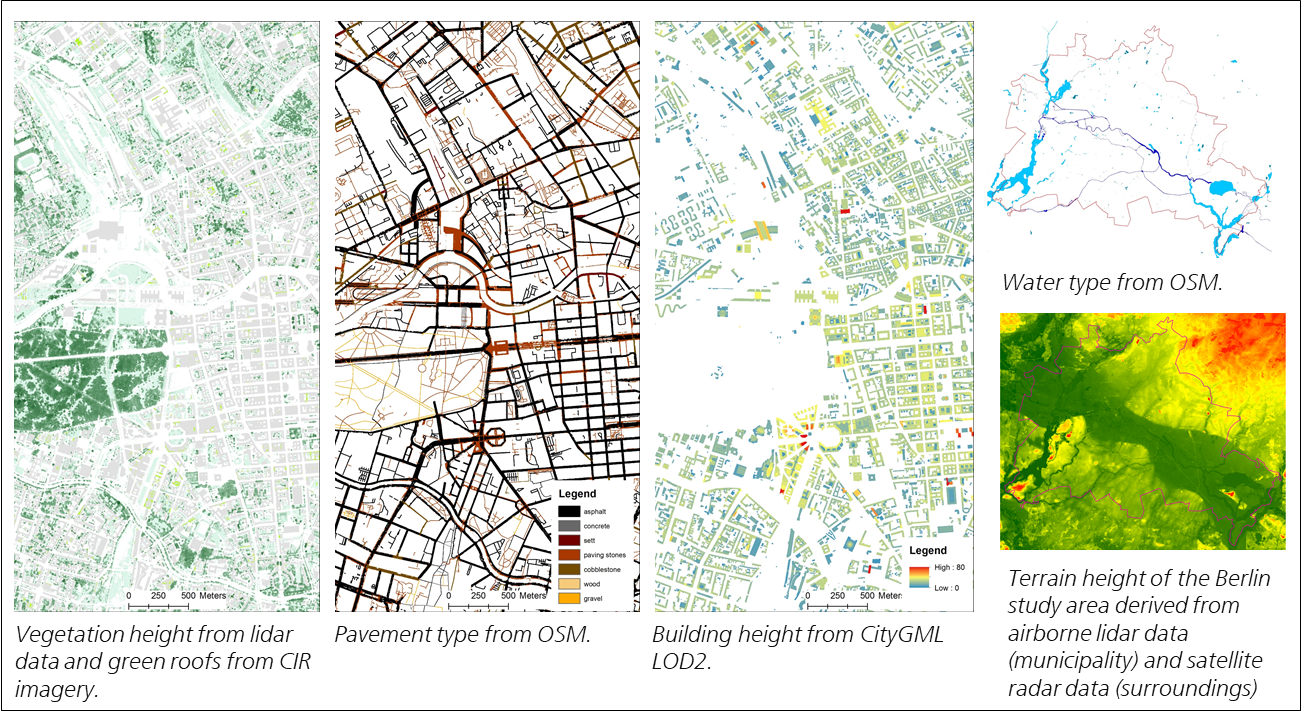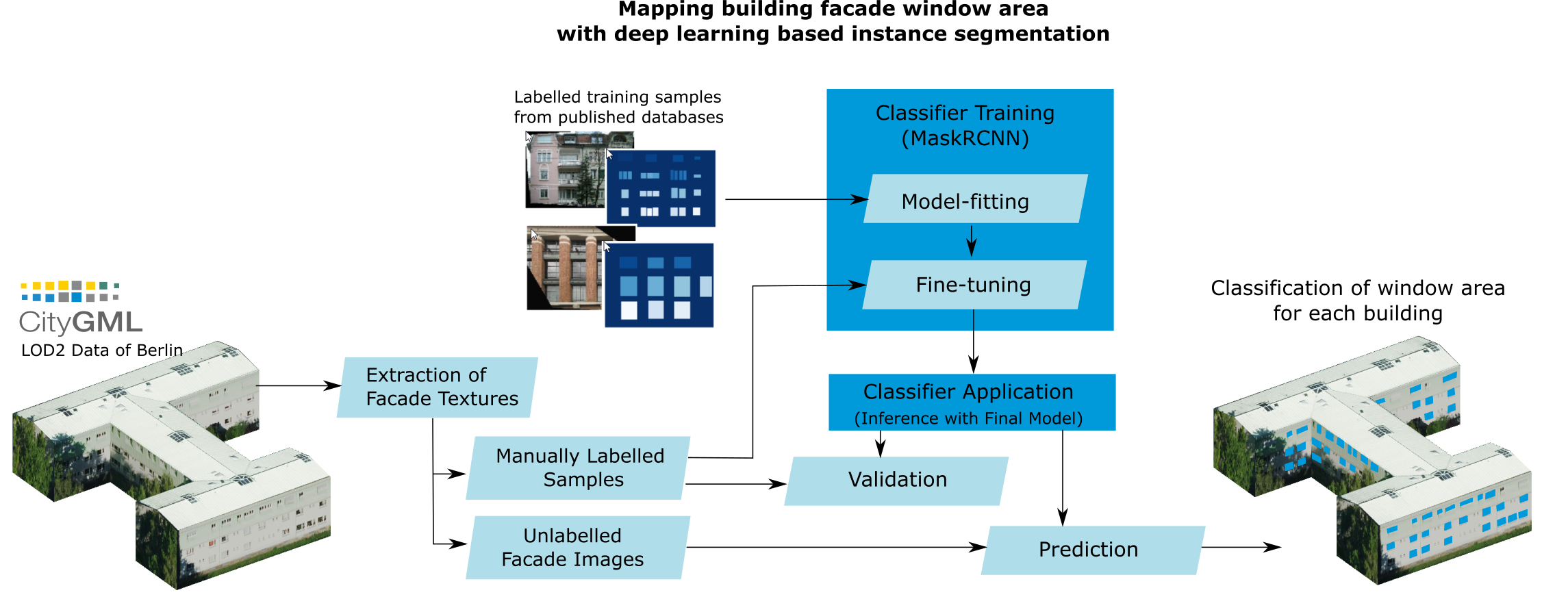| Version 9 (modified by hettrich, 4 years ago) (diff) |
|---|
WP-S5.2: Acquisition of open-source data and automatic generation of surface input parameters
Goals of the project:
WP-S5.2 focuses on the surface input parameters for PALM-4U and aims to improve these. First, open-source data sets are collected that can be used to derive the input parameters in an automated way. For this, free data sets are selected that are at least available Germany-wide, and where possible even at European or global scale. Second, the possibilities of generating new spatial input parameters are investigated to support new simulations in PALM-4U. Possible input parameters are window fraction, façade colour or improved 3D descriptions of trees and buildings, e.g. by using LiDAR data.
Project Tasks:
I) Development of analysis-ready surface data sets
The work in MOSAIK Phase 1 showed the importance of an automated generation of surface input parameters, as well as the provisioning of analysis-ready data. As not all municipalities have the same data available at the same level of detail, it was deemed important to provide base-layers that consistently provide a minimum amount of spatial input parameters, which can be supplemented, if necessary, with local parameters. This basic data-set should only consist of freely accessible data, if possible, to allow their use for everyone intending to test PALM-4U. Many open-source data not only exist for Germany, but also for Europe and globally. Therefore, such base-layers allow the transferability of PALM-4U to cities outside of Germany. In addition to deriving and providing the data layers themselves, work is performed to create and document stand-alone data retrieval software, which could then be distributed with PALM-4U allowing input data retrieval and preparation also on the user side.
II) Development of methods to integrate new high-resolution input data.
In addition to the need for a consistent base-layer data-set, the demand for further spatial input parameters has been identified during the development of PALM in MOSAIK-1. Therefore, the second goal of this work package is to explore new methods of deriving information not readily available in other published data-sets. In particular, we are looking to improve the description of building characteristics from aerial imagery using novel machine learning approaches.
Project structure
This project is conducted at the German Aerospace Centre in Oberpfaffenhofen.
PI: Julian Zeidler Projektmitarbeiter: Dr. Benjamin Leutner
Progress so far:
Base-layer data retrieval and preparation
Data sets have been curated from open-access data-sources and distributed to the project partners. This includes layers such as vegetation heights, surface materials or elevation (Figure 1).

Figure 1: Examples of input parameter (parts of) the study area of Berlin, Germany, for PALM-4U. Created by DLR. Data sources: FIS Broker Berlin (LiDAR, CIR imagery, CityGML), Open Street Map (OSM) and SRTM
AI based building information extraction from aerial imagery.
Recent developments in the realm of artificial intelligence allow for increasingly detailed information retrieval from very high-resolution imagery. In this task we explore the potential of oblique aerial imagery to retrieve detailed building façade information. To this end, we implemented and trained a deep-learning based classifier, which performs instance segmentation on two-dimensional images. In particular it maps facade window area, an important component of building heat exchange, based on texture images from a 3D city model of Berlin (LOD2 CityGML). Training data, sourced from publicly available data-sets, were used in a first iteration to train a Mask-RCNN model. In a second, transfer-learning step the model was fine-tuned to manually labelled 2d images extracted from the LOD2 data. This final model was the validated and used to annotate all unlabeled textures from the LOD2 data, hence creating a map of façade window fractions.

Figure 2: Model-based extraction of façade window area from oblique aerial imagery (provided in CityGML LOD2 format) by means of an instance segmentation algorithm.
References
Heldens, Maronga, Zeidler, Kanani-Sühring, Hanke, Esch (2019): Remote sensing-supported generation of surface descriptors for a highly detailed urban climate model. Joint Remote Sensing Event 22-24 May, 2019, Vannes, France.
Masson, Heldens, Bocher, Bonhomme, Bucher et al. (2020): City-descriptive input data for urban climate models: Model requirements, data sources and challenges. Urban Climate. Vol. 31, 100536, doi: 10.1016/j.uclim.2019.100536.
Heldens, Zeidler, Pavlik, Burmeister, Kanani-Sühring, Maronga, Esch (submitted): Geospatial input data for the PALM model system 6.0: model requirements, data sources, and processing. Submitted to Geoscientific Model Development.
Contact:
Julian Zeidler
Julian.Zeidler[at]dlr.de
Deutsches Zentrum für Luft u. Raumfahrt e.V. (DLR)
Earth Observation Center (EOC), Deutsches Fernerkundungsdatenzentrum (DFD)
Abt. Dynamik der Landoberfläche, Team Smart Cities und Raumentwicklung Oberpfaffenhofen, Deutschland
Attachments (2)
-
WP-S52-figure1.png
(1.2 MB) -
added by hettrich 5 years ago.
Figure 1
- WP-S52-figure2.png (600.2 KB) - added by hettrich 4 years ago.
Download all attachments as: .zip



